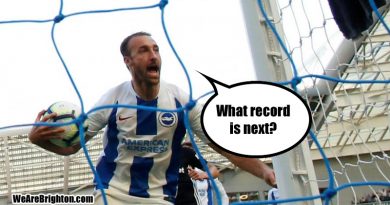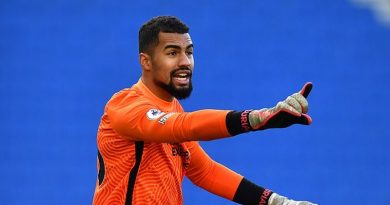Fabian Hurzeler and his defensive high line
Much of the talk in the aftermath of Brighton drawing 2-2 at home to Nottingham Forest has focussed on the part the Albion’s high defensive line played in the result.
Both Tricky Trees goals came from the Seagulls having defenders caught out miles up the pitch. It was a similar story in the League Cup victory over Wolves four days earlier.
The concern over the high defensive line being used by Fabian Hurzeler is not just restricted to Brighton fans. Alan Shearer critiqued it in detail on Match of the Day.
“They play a very high risk high line which they have been punished for already this season,” said Shearer. “They have conceded four goals this season, two of them were today, because of the high line they play.”
“It is risky and they have been caught already this season. If you are prepared to move the ball quickly, you will get in because it’s a high risk.”
“We have seen no pressure on the ball and, when you have no pressure on, you have to drop back. They don’t. They keep that high line and they have been done for it this season.”
With the world and his wife becoming more aware of the issues the high line is causing Brighton, what can Hurzeler do to make it a more effective tactic going forward?
Become more pragmatic using the high line
A high line is part and parcel of Hurzelers’s identity. Ditching it seems pretty unlikely. And it’s not like results have been crap or Brighton are in some sort of crisis playing a high line.
Clean sheets against Everton, Crawley and Ipswich Town. Only one conceded facing Manchester United and Arsenal. Still unbeaten in all competitions.
Yet the warning signs have been there. The Albion have ridden their luck and been blessed with fortune in every game prior to Wolves and Forest exposing the pitfalls of the Brighton high line.
Ipswich could have sneaked a win when Liam Delap ran 70 yards and hit the post. Even League One Crawley found themselves breaking through on a couple of occasions when they weren’t trying to smash the legs of any blue and white shirt which moved.
If the high line is here to stay, should Brighton be more pragmatic in its use? For example when defending a 2-1 lead with 20 minutes remaining against Forest, one of the most effective counter attacking sides in the Premier League?
The pragmatism argument becomes particularly pertinent when you look at who the Albion play next. Chelsea have speed in abundance wherever you look across their forward line.
It could be a long afternoon at Stamford Bridge if the Blues get their tactics right and expose the Brighton high line.
Inject more pace into the Brighton defence to cover the high line
The ideal solution is to sign one or two centre backs as good as Lewis Dunk and Jan Paul Van Hecke but twice as quick. Such a player would be the best defender in the world costing hundreds of millions of pounds, which may admittedly make it unlikely they are joining Brighton.
A more realistic means of injecting pace into the backline is by doing so in the full back positions. Pervis Estupinan provides this on the left, presuming he remembers how to play football after spending most of the Forest draw looking like he had never stepped foot on a pitch in his life.
Joel Veltman on the right has never been blessed with pace. As dependable and reliable defender as he is, that is going to be a problem with Brighton playing such a high defensive line.
Ferdi Kadioglu is an option. But has anyone seen enough of the Turkish international yet to form an opinion of how quick he might be?
Tariq Lamptey is rapid if he can stay fit. Big if. In any case, Hurzeler is not a fan if Lamptey’s lack of minutes even in a much changed line up for the League Cup win over Wolves is anything to go by.
So – and I did give my head a significant wobble before committing this to paper and still thought it plausible – how about Jakub Moder?
Injuries and nobody being sure of Moder’s best position have seen his Albion career never really get off the ground.
Roberto De Zerbi played him at right back in the final match of last season when Manchester United came to the Amex and it was probably the best game Moder has had in a Brighton shirt.
He chased back and caught up with Alejandro Garnacho to make one superb last ditch sliding tackle on as the United winger went one-on-one with Jason Steele.
Moder also famously clocked the fifth fastest sprint of any player in the 2023-24 Premier League season, hitting 36.84 km/h.
Could his Brighton career be saved by an unexpected redeployment as a full back, sweeping around to cover Hurzeler’s high line? Stranger things have happened.
Change formation to better suit the high line
St Pauli sauntered to the Bundesliga 2 title last season under Hurzeler playing a back three. Would a change in formation from the fluid 4-2-3-1 he has used so far at the Albion help the high back line become more effective?
Vital to the effectiveness of that back three was Hurzeler playing a defensive midfielder as the middle centre back. When Hurzeler arrived and the assumption was his 3-4-3 would come with him, prime candidates for the role included Carlos Baleba and Mats Wieffer.
Baleba in particular would become ah interesting option in terms of addressing the lack of pace impacting the current defence.
His speed would enable him to cover Dunk and Van Hecke when opponents break through, potentially providing better cover than was seen when Forest notched their equaliser at the Amex.
Become more effective pressing from the front
Maybe the answer to sorting out the high line actually lies in what Brighton do at the other end of the pitch? Shearer touched on as much with his comments about no pressure on the ball.
As much a part of Hurzeler’s identity as a high line is relentless pressing. If the Albion control possession and win the ball back when they do not have it high up the pitch, it lessens the chances of the opposition launching a quick break which punishes the Albion by catching the back line out.
Danny Welbeck spoke about this aspect after the Forest game: “We know how we have to play against teams who maybe want to get in behind us.”
“The responsibility doesn’t just lie in the backline, it starts from further up the pitch. Everybody has got their role and, for that second goal, we didn’t do what we were supposed to do.”
Knowing when to press and where to be on the pitch out of possession is something which develops with time and practice on the training ground.
Hurzeler has only been working with these players for three months. He has only had access to those who went to the Euros for two months.
And the majority of the £200 million worth of new signings – who you would hope have been brought in with the tactical approach of the new head coach in mind – are yet to play regular Premier League football yet.
Brighton remain a work in progress under Hurzeler. And whilst plenty of work needs to be done defensively, the numbers actually show how much progress he has made already.
The Albion high defensive line has caught opponents offside on 23 occasions in the Premier League this season, more than any other club. Brighton also lead the way for distance covered and counter pressing.
Whilst conceding goals like those scored by Forest and Wolves shine a big spotlight on the risk a high defensive line brings with it, you could argue the Albion have made a decent start to life playing in an alien way. And that they are only going to get better at it.
Fabian Hurzeler on the Brighton high line
Whilst all this has been rather fun to note down with a pint whilst watching Shoreham take on Wick at Middle Road (3-3 at the moment, an absolute Southern Combination League thriller) the last word should probably go to Hurzeler himself.
Sky Sports ran a fascinating in-depth feature before the Forest game looking at how Brighton had started the season from a tactical perspective under the youngest permanent head coach in Premier League history.
In it, Hurzeler discussed the high line: “For me, the high line is something that fits with the compactness of the team. If you want to defend well as a team, you have to be compact, you always have to move as a block.”
“The last line has to work hard, recognise the body language of the opponents. When do they start the deep run? When are they able to play the long ball? It’s again very important to understand the game, not just in possession and out of possession.”
“The high line is a lot of work: it’s about understanding and connection – and it helps to defend very compact. If you defend very compact, the percentage of winning the ball and gaining it as high as possible is high.”
Hurzeler ended the interview being asked what Brighton need to improve. His answer? “A lot!” Expect what the Albion do defensively to be prominent on the list.




